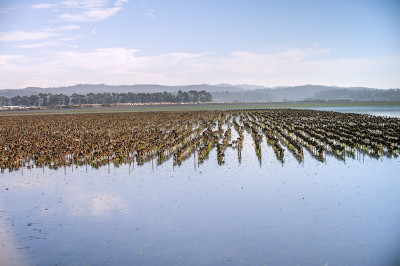California’s coastal waters are changing, making them less hospitable to some marine life and threatening the state’s $45 billion ocean-based economy. A new, first-of-its-kind portal, created with $478,000 in funding from the Ocean Protection Council and California Sea Grant, helps track the increasing acidity and lack of oxygen — or hypoxia — in the region’s coastal ocean.
By delivering real-time data and modeling future trends, the California Ocean Acidification and Hypoxia (OAH) Portal allows fisheries, state managers and others to react swiftly to fluctuations in the ocean’s chemistry. “It provides a central place to learn from all the information being collected,” says Alex Harper, a California Sea Grant Extension Specialist. “Where is ocean acidification occurring the fastest? Where are the impacts going to be the most intense?” By helping untangle where local factors contribute to ocean acidification and hypoxia, the new platform can potentially lead to measures that offset some of these changes.”
California's Accelerated Acidification Crisis
California coastal waters are some of the most biologically productive regions in the world. However, the same dynamics that make them so bountiful also render them exceptionally vulnerable to becoming corrosive.
Wind and currents along the state’s shoreline create seasonal upwellings, in which cold water from the ocean floor rises to the surface. This water has typically spent decades in the deep, which also happens to be the final resting place for dead fishes and plants that sink from the surface. As these organisms decay, they release nutrients. But decomposition also consumes oxygen and produces carbon dioxide (CO2), which reacts with water to form a weak acid.

As a result, the upwelling water is not only highly productive, capable of nourishing abundant marine life, but also more acidic and oxygen-poor than surface waters — and will only become more so. Water that currently wells up in California was pulled into the deep decades ago off the coast of Asia, then traveled as a deep-sea current across the Pacific seabed. Because surface waters absorb atmospheric carbon, human-made CO2 and other pollution can cause water to become more acidic even before upwelling occurs.
Studies show that California’s coastal waters are becoming corrosive at a faster rate than oceans elsewhere in the world. Already, oysters and mussels along the state’s shoreline sometimes struggle to build their shells, for which they need calcium carbonate, a substance that breaks down in an acidic ocean. Also affected are the shells of the microscopic snails, called pteropods, which are an important prey species for commercially important West Coast fish such as herring, mackerel and salmon.
The Capricious Nature of Ocean Chemistry
Warmer oceans also hold less oxygen. In the coastal waters of southern California, hypoxia has become so pronounced during certain times of the year that it makes it hard for some fish species such as northern anchovies to thrive, the Los Angeles Times reported recently.
Neither hypoxia nor ocean acidification are stable phenomena. They vary widely from one stretch of the coast to the next, depending, for example, on whether the topography is suitable for upwellings. Levels of acidity and oxygen also fluctuate daily, driven by factors such as wind and rain.
The California OAH Portal, which builds on the Central and Northern California Ocean Observing System (CeNCOOS) and the Southern California Coastal Ocean Observing System (SCCOOS), combines tens of thousands of data points taken from sensors installed on buoys, piers and wharves throughout the state. Added to that are measurements recorded by scientific expeditions, including some conducted by unmanned submarines. From this data the platform builds geographically detailed, real-time status reports on the acidity and oxygen levels of coastal waters. The portal will also forecast trends, including possible future hotspots — areas where ocean acidification and hypoxia will likely progress especially quickly. After a soft launch earlier this year, the California OAH Portal is currently undergoing beta testing and adding more data streams before being officially released early next year.
While there are other OAH portals operating globally and regionally, the new platform is “very much the first of its kind” when it comes to combining real-world monitoring, modeling and remotely-sensed data as well as targeting this information to the needs of managers and decision-makers in California, says Harper. Fishers, aquafarmers and state managers all depend on such information in different ways.

Shellfish growers, for instance, need to outplant their baby oysters on days with low acidity to give their “spat” the best chances for survival. Fishermen, on the other hand, require information about temperature and oxygen levels to plan their harvesting expeditions. The Dungeness crab, for example, — one of the most valuable fisheries in California — will often flee areas where oxygen levels fall too low. Officials at agencies such as the State Water Board and the Ocean Protection Council, meanwhile, need to gauge how water quality is developing so that they can enforce controls on pollution which might otherwise further stress marine systems.
Measure to Manage
Scientists have realized that ocean acidification and hypoxia can be made worse by local actions. Specifically, coastal water treatment plants that release treated wastewater can escalate acidification, because the sewage they pump into the sea is high in nutrients which can trigger algal blooms that, when decomposing, release CO2.
Theoretically, this could be counteracted by adding to the water crushed-up limestone or other alkaline substances that neutralize acidity – a strategy that oyster growers are already using if the sea around their aquafarms is consistently too corrosive for baby shells.
So by providing better insights, the California OAH Portal might support management action to alleviate some of the changes. “There's an old adage that you can't manage what you don't measure — because without readily available, high-quality and easy to interpret monitoring information, it becomes nearly impossible to change behaviors and management decisions,” says Harper.